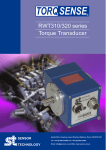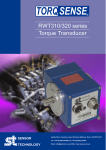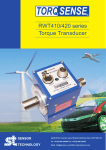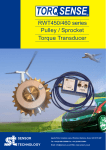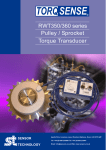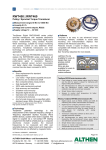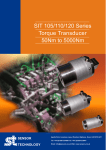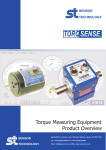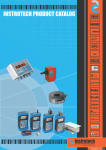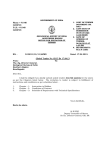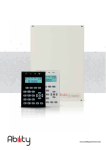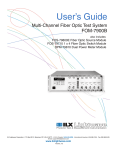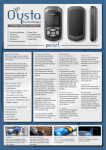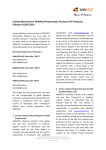Download Datasheet
Transcript
TORQ SENSE ® RWT410/420 series Torque Transducer SENSOR Apollo Park, Ironstone Lane, Wroxton, Banbury, Oxon, OX15 6AY, UK Tel: +44 (0)1869 238400 Fax: +44 (0)1869 238401 TECHNOLOGY Email: [email protected] Web: www.sensors.co.uk SENSOR TECHNOLOGY TORQ SENSE ® Digital RWT410/420 series Torque Transducer TorqSense Digital RWT410/420 series transducers with integral electronics now offer cost effective, noncontact digital rotary torque measurement, using Surface Acoustic Wave technology, suitable for torque monitoring, testing or controlling drive mechanisms. TorqSense RWT410/420 series transducers and their technology are particularly appropriate for OEM applications. The new TorqSense RWT410/420 torque sensors replace the RWT310/320 series and feature all new electronics that have produced significant performance gains in resolution, frequency response, reduced sensor current consumption and faster digital data throughput. Transducer overload has also been increased to 300%. Benefits Minimal shaft length - High shaft stiffness Low inertia – High Speed capability because electronics are not fixed onto shaft Non contact/brushless measurement High Bandwidth 300% safe mechanical overload High accuracy (0.25%) and resolution (0.02%) Excellent noise immunity Integral digital electronics Operates both statically and dynamically - clockwise/anti-clockwise Any full scale torque can be specified within standard range: 1Nm through to 13,000Nm Lifetime warranty Consult factory for ranges greater than 13KNm High speeds available on request TorqSense RWT410 series transducers offer: Fixed voltage or current analog outputs (one for torque and the other for speed or power) for interfacing with analog instrumentation BIT Self-diagnostics for letting the manufacturer know that the transducer’s torque, speed ratings and calibration due date have not been exceeded. Simple ‘Sensor status’ output pin Sensors to monitor shaft temperature for better compensation and accuracy Whereas, TorqSense RWT420 series transducers offer: Digital outputs, such as RS232, CANbus and USB, for interfacing with modern instrumentation and laptops Digital input for configuring transducer via PC 2 x user selectable voltage or current analog outputs (one for torque and the other for speed, power or peak torque) for interfacing with analog instrumentation Transducer configuration software to allow user to changes transducer variables BIT Self-diagnostics for letting users know data is trustworthy, that the transducer’s torque, speed ratings and calibration due date have not been exceeded Simple ‘Sensor status’ output pin Sensors to monitor shaft temperature for better compensation and accuracy Ability to connect up to 10 transducers using USB TORQ VIEW Software TorqView is an easy to use advanced torque monitoring software, available to assist data recording and instrumentation displays that interface with Windows based PCs. Features include: 3 types of display, text files compatible with Matlab and Excel and Real time chart plotting. See TorqView datasheet for more details. Ô Technology TorqSense patented technology is the measurement of the resonant frequency change in 'frequency dependent' Surface Acoustic Wave (SAW) devices, caused when strain is applied. The signal is coupled via a non-contact RF rotating couple from the shaft to a fixed pick-up. Integral electronics enables the resonant frequencies to be measured and offer user selectable features, digital outputs and diagnostics. SAW devices are not affected by magnetic fields. US Patents: US5585571, US6478584. LabView VIs are available for users to design their own process control applications. DLLs are also available for users to write their own custom software. RWT3243R RWT410/420 Series Torque Transducers - Data Specification Parameter Condition Data Units RWT410/420 Torque measurement system Measurement method Strain Dependent Surface Acoustic Wave Resonators (interrogated by an incremental electronic scanning method) (See Notes 1 & Torque range 0–1 0 – 1.1 0 – 21 0 – 101 0 - 501 0 – 2001 Nm 2 below) to 0 - 20 to 0 - 100 to 0 - 500 to 0 - 2000 to 0 - 13000 [0 - 10] [0 – 11 to 0 - 200] [0 – 201 to 0 - 1000] [0 – 1001 to 0 - 5000] [0 – 5001 to 0 - 20000] [0 – 20001 to 0 - 175000] [lbf.in] Shaft size (diameter) 6 12 20 30 50 75 mm Rotation speed/angle of rotation measurement system Measurement method Opto switch through slotted disc Direct output signal Pulse output direct from opto switch (TTL, 5V square wave), output is independent of any analog or digital processing. Digital Processing Processing Method Update rate for analog and digital outputs Techniques Mode 1 (Slow Method) 1 Hz Processing modes run Frequency Count simultaneously and can be 0 RPM 1 applied to either analog < 2000 RPM RPM Mode 2 (Fast Method) channel or accessed Hz Period Count individually via a digital > 2000 RPM RPM x ( 1 / ( (RPM - 1) / 2000 + 1 ) ) connection. (See Note 3) Rotational speed (max) 30,000 20,000 15,000 12,000 9,000 6,000 RPM Temperature Measurement method IR temperature sensor monitoring actual shaft temperature 0 Temperature accuracy C 1 0 Reference temperature, TRT 20 C 0 Operating range, ∆TO -10 to +50 C 0 Storage range, ∆TS -20 to +70 C Temperature drift (FS) Max 0.05 %FS/0C Specifications Combined non-linearity and 0.25 (0.5 for 2.5Nm and below) %FS hysteresis Resolution 0.02 %FS Repeatability 0.1 %FS RWT410 Series Transducers ONLY %FS Accuracy 200C, SM (See 0.25 (0.5 for 2.5Nm and below) Note 4) (See Notes 5&6) 3dB Bandwidth RWT420 Series Transducers ONLY (See Note 5) Digital averaging Accuracy 200C, SM (See Note 4) 312 (default ave. = 16) Hz 2 4 8 16 32 64 128 N 0.7 0.5 0.4 0.25 0.25 0.25 0.25 %FS (See Note 6) 3dB Bandwidth 2500 1250 625 312 156 78 39 Hz Analog output Output voltages Vdc Options available: 1 / 5 / 10 / Unipolar (RWT410 Series default setting is 5Vdc) (Torque/Speed/Power) (RWT420 Series output voltages are user selectable) Load impedance Maximum 1 KΩ Output currents mA Options available: 4-20 / 0-20 / 128 (Torque/Speed/Power) (RWT420 Series output currents are user selectable) 4-20mA Loop resistance Should not exceed 400 Ω Digital output (RWT420 Series Transducers ONLY) Connections CAN Bus RS232 USB Configuration CAN 2.0B, 11bit Message Identifiers Data Bits: 8, Parity: None, Stop Bits: 1 USB 2.0 Full-Speed Baud Rate(s) 1 Mbps, 500 Kbps, 250 Kbps, 100 Kbps 115200 bps, 38400 bps, 9600 bps 12 Mbps Single Transfer Up to 500 Hz Output Rate (Note 7) Up to 10 KHz Up to 1.1 KHz Bulk Transfer Up to 10 KHz Power supply Nominal voltage, VS 12 to 32 (max) V Current consumption, IS 230 (max) @ 12 VDC mA Power consumption, WS 3 W Allowed residual ripple of 500 mVp-p supply voltage, Vripple (above nominal supply voltage) Electromagnetic compatibility EMC compatibility EN 61326:2006 Note 1: Any torque/FSD is possible between ranges – please specify max rated torque. Note 2: Max rated torque should not be exceeded. Note 3: Please consult factory for applications requiring rotational speeds that exceed maximum figures given. Transducers fitted for IP65 will have running speeds considerably reduced, increased drag torque and accuracy can be affected. Note 4: SM – Static Mode. Dynamic values will depend upon user application and has to be adjusted accordingly. Note 5: Digital averaging can be configured by user to optimise accuracy/frequency response for specific user applications. Digital averaging default setting is N=16. For details see User Manual. Note 6: >5Khz Sample Rate. Up to 10Khz sample rate possible, please consult factory. Digital averaging also affects the analog output, max analog output 3dB Bandwidth = 5Khz when digital average is 1. Note 7: Output rate figures are calculated from the time taken to capture 10000 torque readings. Testing was conducted with each connection method configured at its maximum baud rate. The maximum output rate available for CAN and USB is dependant on the transducers setup. USB - USB is a host based bus architecture, because of this the output rate achievable will be affected by other bus traffic and host activity. USB has two transfer modes, Single Transfer which requests 1 reading at a time and Bulk Transfer which transfers readings in blocks of 50 Torque/Speed pairs. CAN Bus - to achieve a Torque reading output rate of 10KHz, the Speed reading output rate must be reduced to 100Hz. © Sensor Technology Ltd 2015 RWT3722R (Rev3) Data parameters measured at +20°C Sensor Technology Ltd reserves the right to change specification and dimensions without notice. RWT410/420 Series Torque Transducers Dimensions (1Nm to 100Nm) Parameter Data Mechanical Properties Torque (Max) 1 2.5 Shaft Code CF DA Shaft Size 6 (Diameter) Torsional 0.23 1.28 Stiffness Mass moment 0.45 5.96 of inertia, LV Max measurable load limit Static safe load breaking Shaft weight, 0.03 0.14 approx 0.7 0.8 Transducer with shaft weight, approx 3.9 DF 6 DB 8.5 DC 12 13 DG Units 17.5 DD 20 DE 30 EB 55 EC 85 ED 100 EE Nm 20 mm 1.3 1.32 1.6 1.7 1.8 1.9 4.1 6.4 8.1 9.2 6.00 6.04 6.13 6.18 6.24 6.42 22.9 23.9 25.4 27.2 KNm/rad x 120 (of rated torque) 10-6 kg.m2 % 300 (of rated torque) % 0.14 0.14 0.14 0.15 0.15 0.15 0.36 0.37 0.40 0.41 kg 0.8 0.8 0.8 0.8 0.8 0.8 1.0 1.0 1.1 1.1 kg Data parameters measured at +20°C Sensor Technology Ltd reserves the right to change specification and dimensions without notice. © Sensor Technology Ltd 2015 RWT3722R (Rev3) RWT410/420 Series Torque Transducers Dimensions (101Nm to 500Nm) Parameter Data Mechanical Properties Torque (Max) Shaft Code Shaft Size (Diameter) Torsional stiffness Mass moment of inertia Max measurable load limit Static safe load breaking Shaft weight, approx Transducer with shaft weight, approx 175 FA 32.9 138.9 225 FB 35.6 143.1 Units 265 FC 30 350 FD 37.2 147.7 37.9 151.9 500 FE Nm mm 39.8 174.2 kNm/rad 10-6 kg.m2 x 120 (of rated torque) % 300 (of rated torque) % 1.1 1.1 1.1 1.2 1.2 kg 2.4 2.4 2.4 2.5 2.5 kg Data parameters measured at +20°C Sensor Technology Ltd reserves the right to change specification and dimensions without notice. © Sensor Technology Ltd 2015 RWT3722R (Rev3) RWT410/420 Series Torque Transducers Dimensions (501Nm to 13000Nm) Parameter Data Mechanical Properties Torque (Max) 650 Shaft Code GE Shaft Size (Diameter) Torsional TBC Stiffness Mass moment of TBC inertia Max measurable load limit Static safe load breaking Shaft weight, TBC approx TBC Transducer with shaft weight, approx 850 GA 1100 GB 50 1350 GC 2000 GD 3000 HA TBC 199.2 TBC 214.1 TBC TBC 1330 TBC 1497 TBC Units 4000 HB 6000 HC 75 10000 HF 13000 HG Nm TBC 914.4 945.5 TBC kNm/rad TBC 7932.7 9407.1 TBC 120 (of rated torque) x 10-6 kg.m2 % 300 (of rated torque) % mm TBC 3.9 TBC 4.1 TBC TBC 10.2 10.6 11.2 kg TBC 7.1 TBC 7.3 TBC TBC 13.4 13.8 14.4 kg Data parameters measured at +20°C Sensor Technology Ltd reserves the right to change specification and dimensions without notice. © Sensor Technology Ltd 2015 RWT3722R (Rev3) RWT410/420 Series Torque Transducers - Standard Range ● – Standard feature ◊ – Optional feature Torque, Speed, Power Outputs Torque only Torque & Speed (60 pulses/rev) Torque & Speed (360 pulses/rev) Torque & Power (60 pulses/rev) Torque & Speed (60 pulses/rev) or Power Torque & Speed (360 pulses/rev) or Power Standard features Keyed Shaft Ends Voltage output ±5v FSD (Fixed) Voltage outputs from ±1v to ±10v FSD and unipolar (Variable) RS232 output Torque Averaging and Torque Peak Self Diagnostics Internal temperature measurement Deep grooved shielded bearings with oil lubrication Ingress Protection (IP) 54 Optional features Plain Shaft Ends Splined Shaft Ends Voltage output ±1v FSD (Fixed) Voltage output ±10v FSD (Fixed) Customer Specified Voltage Output (Fixed) Current output 0-20mA (Fixed) Current output 4-20mA (Fixed) Current output 12±8mA (Fixed) RWT410/420 Series RWT410 RWT420 410 420 412 413 421 (See Note 9 below) Sealed Bearings Ingress Protection (IP) 65 (See Note 10 below) Not yet available 422 ● ● ● Remarks User to specify RPM/FSD when ordering Not yet available User to specify Power/FSD when ordering Outputs are user selectable 411 K B 1Nm will have flats Output is user selectable ● ● ● ● ● ● ● ● ● ● ● ◊ ◊ P ◊ ◊ ◊ ◊ T A C Value available on RWT420 series only ◊ U ◊ D ◊ E ◊ V Current output 0-20mA, 4-20mA & 12±8mA (Variable) USB 2.0 full speed 12 Mbps Digital output CANbus output High Speed Bearings Option Code ◊ F ◊ ◊ G H ◊ ◊ J ◊ ◊ S ◊ ◊ L Shaft length will be longer than keyed end shafts – consult factory for length Consult factory for details In place of Option B In place of Option B In place of Option B. User to specify range/scale when ordering In place of Voltage output options In place of Voltage output options In place of Voltage output options Current output is user selectable and in place of Voltage output. However user can reselect a Voltage output, if required. (Note 8) In place of RS232 ouput Consult factory for maximum speed allowance. Note 8: 2 x analog channels available. Default settings are Channel 1 (voltage/current) – torque. Channel 2 (voltage/current) – speed or power, if ordered. Note 9: At very high speeds, for better balance the factory recommend plain or splined shafts. Note 10: Transducers fitted for IP65 will have running speeds considerably reduced, increased drag torque and accuracy can be affected. Data parameters measured at +20°C Sensor Technology Ltd reserves the right to change specification and dimensions without notice. © Sensor Technology Ltd 2015 RWT3722R (Rev3) RWT410/420 Series Torque Transducers – Connector and Lead Options Connectors & Leads Analog Connector 12 Pin Lumberg (female) RWT410/420 Series RWT410 RWT420 ◊ Digital Connector 12 Pin Lumberg (male) Option Code ◊ ACC 1 ◊ ACC 2 ◊ ACC 3 For connecting RWT to user’s system via 15 pin ‘D’ connector ◊ ACC 4 For connecting RWT to user’s system via 15 pin ‘D’ connector Digital Lead (Length 2.5m) 12 Pin Lumberg (male) to 15 way ‘D’ type connector (male) Digital Lead Adapter (Length 1m) 15 Way ‘D’ type (female) to RS232 and Power Connectors ◊ ACC 5 ◊ ACC 6 ◊ ACC 8 ◊ ACC 9 Digital Lead Adapter (Length 1m) 15 Way ‘D’ type (female) to RS232, USB and Power Connectors Digital Lead Adapter (Length 1m) 15 Way ‘D’ type (female) to CANbus and Power Connectors Digital Lead Adapter (Length 1m) 15 Way ‘D’ type (female) to CANbus, USB and Power Connectors For user to self wire ◊ Analog Lead (Length 2.5m) 12 Pin Lumberg (female) to 15 way ‘D’ type connector (female) Remarks/Purpose For user to self wire For connecting RWT to PC via RS232 [Also needs Digital Lead (ACC4) to connect to RWT] For connecting RWT to PC via USB (Option G) or RS232 [Also needs Digital Lead (ACC4) to connect to RWT] For connecting RWT to PC via CANbus (Option H) [Also needs Digital Lead (ACC4) to connect to RWT] For connecting RWT to PC via USB (Option G) or CANbus (Option H) [Also needs Digital Lead (ACC4) to connect to RWT] RWT410/420 Series Torque Transducers – Additional related products Code ETD PSU 1 SBU 1 TV Transducer Display ETD AC Mains Adapter Power Supply Transducer Signal Breakout Unit TorqView Remarks/Purpose Display readout For providing 12-32Vdc Torque Monitoring Software ACC 3&4 12 Pin Lumberg 15 W ay D Type ACC 5 or 8 RS232 (ACC 5) / CANbus (ACC 8) 15 W ay D Type (connects to ACC4) Power ACC 6 or 9 RS232 (ACC 5) / CANbus (ACC 9) USB 15 W ay D Type (connects to ACC4) Power Data parameters measured at +20°C Sensor Technology Ltd reserves the right to change specification and dimensions without notice. © Sensor Technology Ltd 2015 RWT3722R (Rev3) When ordering a Torque Transducer please note that any torque/FSD is possible between ranges – please specify rated torque and options using the following format: For example: RWT 411 - 15Nm - K-CL Your transducer requirement: RWT Max speed (if applicable) A ‘basic’ transducer with torque and speed outputs, rated and calibrated to 15Nm FSD with keyed ends, ±10v and IP65 protection. RPM Connector & Lead options (if applicable) See over Additional related products (if applicable) See over Glossary of terms and definitions used in this datasheet Surface Acoustic Wave (SAW) - An acoustic wave travelling along the surface of a material having some Strain dependent SAW resonators – A type of elastic SAW device, which changes its resonant properties elasticity, with amplitude that typically decays exponentially with the depth of the substrate. when it is subjected to axial strain/compression. TorqSense uses this principle, which is protected by a number of patents. Incremental Electronic Scan (IES) – The most successful and precise method for interrogating strain dependent SAW resonators. The IES interrogation method uses a processor controlled frequency synthesiser to excite the SAW resonators over a defined range of frequencies and measure the reflected signal. TorqSense uses this patented method. Resolution of the IES method - The minimum measurable number corresponding to the stress/strain sensitive resonance point of the SAW resonator. The value is limited by following the factors: frequency resolution of the synthesiser, which is 1000 times greater then overall resolution of the system. relationship between frequency response and resolution. Increments of the resolution will proportionally decrease the system’s frequency response. TorqSense systems are optimised for the best performance that suits most applications. However, on the RWT420 series models customers do have the capability to adjust the system performance. Frequency response of the IES method – The measure of the TorqSense system's response at the output to a signal of varying frequency at its input. The frequency response is typically characterised by the magnitude of the system's response, measured in dB. There are two ways of characterising the system’s frequency response: 0.1dB frequency range, where the output magnitude of the signal is different to the input magnitude of the signal by not more then 0.1dB (practically absolutely identical). 3dB frequency range, where the output magnitude of the signal is 0.707 of the input signal. This is a common standard for most applications, unless it specifically says otherwise. This standard is also used to characterise the TorqSense system’s frequency response. Accuracy - The degree of conformity of a measured or calculated quantity, which will show the same or similar results. Accuracy of the overall TorqSense system is limited by the combined error of several factors such as linearity, hysteresis, temperature drifts and other parameters affecting measurements. If errors in the system are known or can be estimated, an overall error or uncertainty of measurement can be calculated. Digital averaging – The application of algorithms to reduce white noise. In any electronic system, electronic white noise is mixed with the signal and this noise usually limits the accuracy. To reduce the influence of white noise and increase the accuracy of the system different averaging algorithms can be applied. In the TorqSense system a flying digital averaging technique is applied to reduce the white noise commensurate with the level of accuracy required. However, as any averaging algorithm works as a low pass filter, the more averaging that is applied the lower the frequency response. Therefore, each Torqsense system should be optimised to the customer’s requirements by choosing the right combination of accuracy/frequency response. Please see relevant part of the Datasheet and User Manual. Data parameters measured at +20°C Sensor Technology Ltd reserves the right to change specification and dimensions without notice. © Sensor Technology Ltd 2015 RWT3722R (Rev3)









